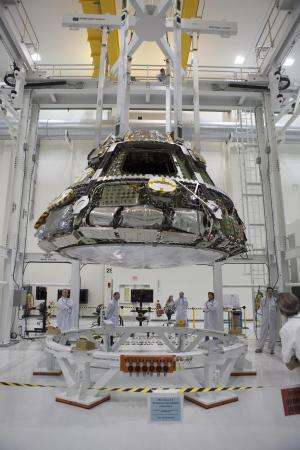The Orion crew module is placed in a lift fixture to prepare for the heat shield installation.
Lockheed Martin and NASA engineers have started the process of installing the largest heat shield ever built onto the Orion spacecraft's crew module. The heat shield installation marks one of the final steps in the spacecraft's assembly leading up to its first test flight, Exploration Flight Test-1 (EFT-1), later this year.
EFT-1 will provide engineers data about the heat shield's ability to protect the crew module from the extreme 4000-degree heat of reentry and an ocean splashdown following Orion's 20,000 mph reentry from space. In addition, key systems such as avionics, separation events, attitude control and guidance, parachute deployment, and ground operations will be evaluated. Comprehensive data from the test flight will influence design decisions most critical to crew safety to lower risks and safely carry humans on future missions to deep space.
The team remains on schedule to complete the following milestones for the Dec. 4, 2014 launch date:
- The crew module and service module will mate together and will undergo functional testing
- The backshell tiles and forward bay cover will be installed onto the crew module
- The crew module and service module will mate to the Delta IV Heavy second stage adapter
- The spacecraft will be fueled and serviced at the Kennedy Space Center Payload Hazardous Servicing Facility
- The launch abort system will be stacked on top of the spacecraft
- The spacecraft will be prepped and transported to Launch Pad 37 where Lockheed Martin and United Launch Alliance will perform pad integration and launch operations
"This team has done a great job keeping us on track for Orion's first test flight," said Cleon Lacefield, Lockheed Martin vice president and Orion program manager. "That's no easy task when you're designing and building a unique vehicle for human exploration of deep space."
Provided by Lockheed Martin























